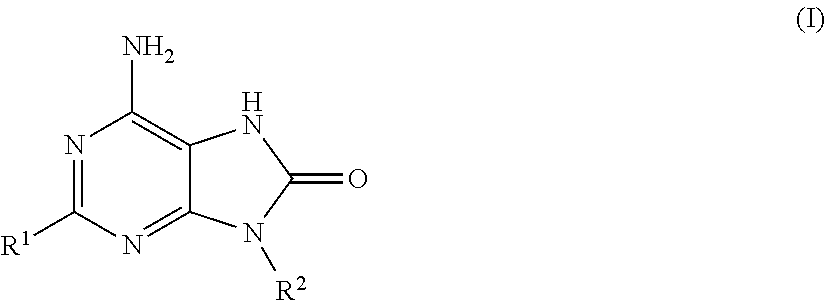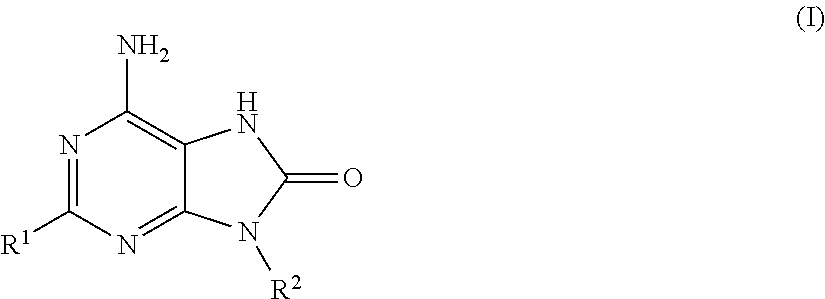Adenine derivatives
a technology of adenine derivatives and derivatives, applied in the field of compounds, can solve the problems of disease modification, failure to show sustained viral response, and inability to control viral load,
- Summary
- Abstract
- Description
- Claims
- Application Information
AI Technical Summary
Benefits of technology
Problems solved by technology
Method used
Image
Examples
example 1
6-Amino-2-butoxy-9-[(1-ethyl-3-piperidinyl)methyl]-7,9-dihydro-8H-purin-8-one
[0868]
[0869]2-Butoxy-9-[(1-ethyl-3-piperidinyl)methyl]-8-methoxy-9H-purin-6-amine (99 mg) was dissolved in methanol (2 ml) and 4N hydrogen chloride in dioxan (1 ml) added. After 5 hours the reaction mixture was stripped, quenched with water then saturated sodium hydrogen carbonate added, when a solid precipitated. This was filtered, washed with water and dried to yield 81 mg of the title compound as a white solid.
[0870]MS calcd for (C17H28N6O2)+=348
[0871]MS found (electrospray): (M+H)+=349
[0872]1H NMR ((CD3)2SO): δ 9.85 (1H, s), 6.40 (2H, s), 4.14 (2H, t), 3.55 (2H, m), 2.64 (2H, m), 2.26 (2H, m), 2.02 (1H, m), 1.87 (1H, m), 1.73 (1H, m), 1.64 (3H, m), 1.54 (1H, m), 1.38 (3H, m), 0.93 (7H, m).
example 2
6-Amino-2-(butylamino)-9-[(1-ethyl-3-piperidinyl)methyl]-7,9-dihydro-8H-purin-8-one
[0873]
[0874]N2-Butyl-9-[(1-ethyl-3-piperidinyl)methyl]-8-methoxy-9H-purine-2,6-diamine (120 mg) was dissolved in methanol (2 ml) and 4N hydrogen chloride in dioxan (1 ml) added. After 5 hours the reaction mixture was stripped, quenched with water then made basic with 1M aq potassium carbonate. The resulting solid was filtered, washed and dried to give the title compound as a crystalline solid, yield 86 mg.
[0875]MS calcd for (C17H29N7O)+=347
[0876]MS found (electrospray): (M+H)+=348
[0877]1H NMR ((CD3)2SO): δ 9.52 (1H, s), 6.16 (1H, m), 5.95 (2H, s), 3.50 (2H, m), 3.16 (2H, m), 2.64 (2H, m), 2.25 (2H, m), 2.02 (1H, m), 1.85 (1H, m), 1.75-1.58 (2H, m), 1.58-1.42 (3H, m), 1.41-1.22 (3H, m), 0.99-0.85 (7H, m).
example 3
2-(Butyloxy)-9-(4-piperidinylmethyl)-9H-purin-6-amine hydrochloride
[0878]
[0879]4N hydrogen chloride in dioxane (5.3 mL) was added to a solution of 1,1-dimethylethyl 4-{[6-amino-2-(butyloxy)-8-(methyloxy)-9H-purin-9-yl]methyl}-1-piperidinecarboxylate (630 mg) in methanol (16 mL). After 4.5 hours at room temperature, the reaction mixture was concentrated and dried under high vacuum. Purification by chromatography on silica gel eluting with a gradient of chloroform / methanol / water 90:10:1 to 75:25:1 afforded the title compound as a white solid (404 mg).
[0880]1H NMR (CD3OD): δ 4.84 (5H, s), 4.27 (2H, t), 3.79 (2H, d), 3.40 (2H, d), 2.96 (2H, t), 2.21 (1H, m), 1.92 (2H, d), 1.75 (2H, m), 1.47-1.60 (4H, m), 1.00 (3H, t).
PUM
 Login to View More
Login to View More Abstract
Description
Claims
Application Information
 Login to View More
Login to View More - R&D
- Intellectual Property
- Life Sciences
- Materials
- Tech Scout
- Unparalleled Data Quality
- Higher Quality Content
- 60% Fewer Hallucinations
Browse by: Latest US Patents, China's latest patents, Technical Efficacy Thesaurus, Application Domain, Technology Topic, Popular Technical Reports.
© 2025 PatSnap. All rights reserved.Legal|Privacy policy|Modern Slavery Act Transparency Statement|Sitemap|About US| Contact US: help@patsnap.com



